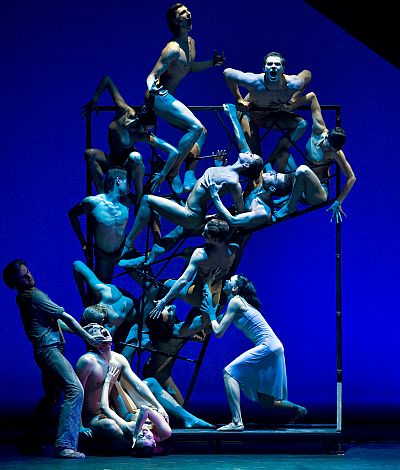 United States Eifman: Rodin, Eifman Ballet of St. Petersburg, Dorothy Chandler Pavilion, Los Angeles, 12.6.2015-14.6.2015 (JRo)
United States Eifman: Rodin, Eifman Ballet of St. Petersburg, Dorothy Chandler Pavilion, Los Angeles, 12.6.2015-14.6.2015 (JRo)

Dancers:
Rodin: Oleg Gabyshev
Camille: Lyubov Andreyeva
Rose Beuret: Yulia Manjeles
Production:
Choreography: Boris Eifman
Music: Maurice Ravel, Camille Saint-Saëns, Jules Massenet, Claude Debussy, Erik Satie
Sets: Zinovy Margolin
Costumes: Olga Shaishmelashvili
Lighting: Gleb Filshtinsky, Boris Eifman
Famous artists in torment are a subject of fascination in the popular imagination. Make it two tormented artists in a romantic relationship and the appeal doubles. Biographies, films, and even novelizations abound on the lives of, for example, Mary and Percy Bysshe Shelley, Frida Kahlo and Diego Rivera, and Simone de Beauvoir and Jean-Paul Sartre.
In this vein, Boris Eifman, the Russian choreographer known internationally for his heavily plotted, narrative ballets, explores the intense relationship of the sculptor Auguste Rodin with the artist Camille Claudel. It is a subject ripe for the Eifman technique, which interweaves classical ballet movement, modern dance, and, in the choreographer’s words, “ecstatic impulses” all in the service of psychological dance theatre. We travel back and forth in time, largely between the mental asylum where Camille was incarcerated and Rodin’s workshop. Zinovy Margolin’s set is an architectural marvel of lines and planes reminiscent of Russian Constructivist theatre sets of the early twentieth century. The angles, multi-levels, and platforms provide the backdrop for the workshop, the asylum, and various other locations such as the dance hall of Act II.
Set to a selection of music by Ravel, Saint-Saëns, Massenet, Debussy, and Satie, which is seamlessly interwoven, the ballet has many moments of breathtaking beauty, imaginative choreography, and penetrating insight, all superbly danced by Oleg Gabyshev as Rodin, Lyubov Andreyeva as Camille, and Yulia Manjeles as Rodin’s lifelong companion, Rose Beuret.
Like the clay with which Rodin and Camille sculpt their forms, the choreography in Act I is tied to the earth and reminiscent of Martha Graham’s elemental movements. Echoes of Vaslav Nijinsky’s choreography also haunt the piece, and awareness of his declining mental state adds another layer of meaning. Art and sensuality seem inextricably mixed, particularly in the sensuality of the clay as depicted in Rodin’s “modeling” of form. In a mesmerizing scene, Rodin stands before a group of semi-nude male figures crouched on a rotating circular table. As Rodin pushes, twists, and strokes these figures, he seems to draw form out of the mass of bodies. A limb extends slowly or a knee juts out until the figures stand erect, becoming Rodin’s Burghers of Calais. The magic is achieved through Eifman’s choreography, Gabyshev’s raw physical power, and the sculptural lighting of Gleb Filshtinsky.
Notable in Act I is a dance for the asylum inmates, women dressed in cream-colored nightdresses and lace sleeping caps who dance holding pillows, which in turn become babies cradled in their arms, toys they play with, or a repository for their tears. At some moments one thinks of the spectral Willis of Giselle, the victims of their sweethearts’ indifference, at another, the children at play in The Nutcracker, rocking their dolls or frolicking about the Stahlbaum house. Both instances help heighten dramatic tension.
In a dream sequence, which serves as a counterpoint to the earthier and more tortured dancing of Act I, couples dressed in silky charcoal grays, beautifully conceived by costume designer Olga Shaishmelashvili, dance with classical elegance to Saint-Saëns Dance Macabre. More confusing, however, is the dance of the workshop assistants at the beginning of the act, which looks like a nod to the cowboys of Agnes de Mille’s Rodeo or the sailors of Jerome Robbins’s Fancy Free – cute and lively, but a bit out of place in a French sculptor’s workshop.
All in all, Act I is a gem of dance drama. Even the tortured, angst-driven dancing manages to stay just on the right side of romantic sentimentality. Gabyshev’s Rodin as consumed artist and sexual predator has an iconic reality to it. Andreyeva’s Camille, Rodin’s ambitious, sensual, yet unstable student and fellow artist, is a passionate performance. And Manjeles is majestic as the long-suffering Rose.
Act II begins with another striking effect: Rodin creating the Gates of Hell. On metal scaffolding that represents an immense doorway, dancers configure in positions reflecting Rodin’s famed relief sculpture. Unfortunately, problems arise as the act progresses and the proverbial kitchen-sink syndrome derails the ballet. What had been a precisely structured examination into the life of art, tackling issues of creativity, recognition, fame, love, and madness, turns into a pastiche of nineteenth-century dance references and an unnecessary heightening of the angst-ridden choreography. A harvest wine dance à la Giselle with girls in bright peasant dresses grows out of nowhere (justified by Rodin’s dreaming of his first meeting with Rose), followed a bit later by a Parisian cancan scene when Camille leaves Rodin for the bright lights of the big city. Both are crowd-pleasers, no doubt, but Eifman’s showmanship here gets in the way of his artistry. Further compromising Act II is the overstated tension within the love triangle of Rodin, Camille, and Rose. The tortured dancing grows repetitive and dilutes the undeniable power of the first act.
Where Eifman succeeds in Act II is in turning the hammering of stone, done first by Camille and then by Rodin in the final scene, into blazing dance movement. With his back towards us and bare-chested, Gabyshev works away at the stone, his body torqueing side to side; and we are left with the image of the artist as Hephaestus forging life out of the furnace of human will and desire.
Jane Rosenberg